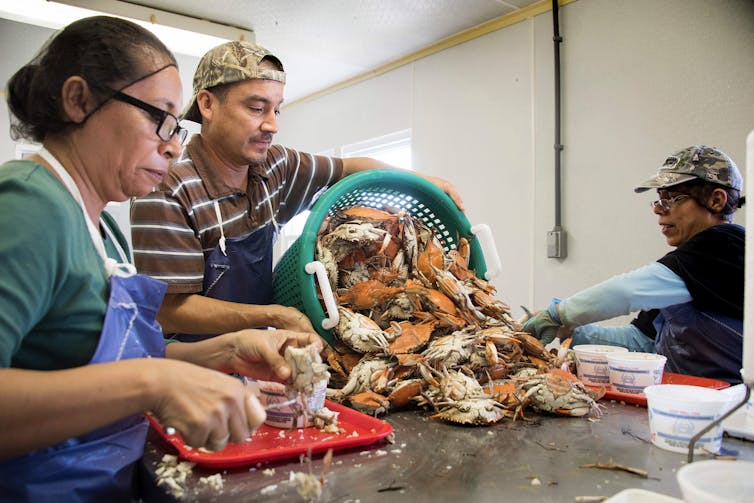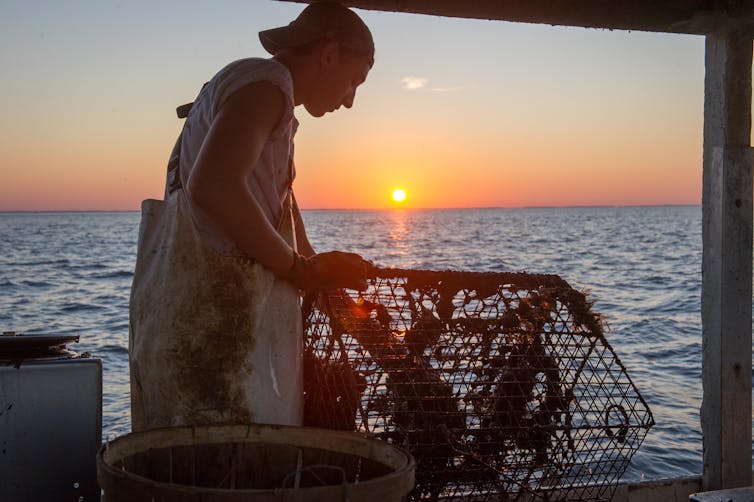Every summer, people flock to Maryland to eat blue crabs. Named for their brilliant sapphire-colored claws, blue crab is one of the most iconic species in the Chesapeake Bay. The scientific name for blue crabs, Callinectes sapidus, means “beautiful savory swimmer.”
In restaurants and at home, diners pile steamed and seasoned blue crabs in the middle of a table covered in paper. Then, using small mallets, knives, bare hands and fingers, they break open the hard shells and extract the juicy meat from inside.
It is a messy experience, especially with Old Bay seasoning and beer known locally as Natty Bohs, one that is quintessentially Maryland.
Though many people know firsthand how difficult it is to pick and clean crab meat, they often don’t realize how crab is processed when it is sold in stores already picked and cleaned. Most people also may not know that crab picking is a livelihood for many, mainly poor, women.
For generations, African American women from Maryland’s rural, maritime communities labored for crab houses on the Eastern Shore.
Today, fewer than 10 crab houses are left on the Shore. The workforce consists of mainly female migrant workers from Mexico who do the grueling job of picking crab for eight to nine hours a day, from late spring to early fall. They make on average of US$2.50 to $4.00 for every pound of crabmeat they pick.
That pay is roughly one-tenth to one-twelfth of the wholesale price of one pound – or about a half of a kilogram – of the seafood they pick, which is $35 to $44. In comparison, the Maryland minimum wage is $13.25 an hour, while the federal minimum wage is $7.25.
Rise of immigration in rural America
Over 2.1 million migrants and immigrants work in jobs growing and processing food in the United States, playing an essential role in feeding Americans.
As an anthropologist and global health researcher, my work has shown that they are part of an increasing trend in rural America. Since 1990, immigrants have been moving to small towns and rural regions at unprecedented rates, accounting for 37% of the overall rural population growth from 2000-2018.
Some rural counties, like Stewart County in Georgia and Franklin County in Alabama, have experienced growth rates of over 1,000% in their foreign-born population, which have boosted their local economies and mitigated rural population decline.
Maryland’s rural Eastern Shore, for instance, has experienced a rapid rise in immigration since 2000. From 2010 to 2019, migration was the primary source of population growth, with the foreign-born population increasing by 90%.

Many immigrants come to this region to find work in agriculture, poultry and seafood processing. Some come directly from Mexico, Central America and Haiti.
Typically, farmworkers have temporary visas and arrive in late spring and early summer and stay through the growing season. Migrant Mexican women who work in crab processing also follow the same seasonal employment pattern. Others, like those working in poultry processing plants, have settled here more permanently, either as undocumented or permanent residents.
At risk of exploitation and injury
Immigrant workers in rural regions work dangerous jobs and are exposed to pollution, deplorable living conditions and limited safety training.
Additionally, immigrant workers are among the lowest paid and lack access to health information, preventive care and medical treatment. Dry skin, cuts, scrapes, rashes, chronic pain and broken bones are common among immigrants who work in agriculture, poultry and seafood processing.
These workers also suffer from numerous invisible injuries such as discrimination, verbal harassment and physical exploitation.
Challenges to rural health
Despite the daily risk of harm, migrant workers in rural regions have limited access to health care and rely on mobile clinics, local health departments and community health centers.

But these facilities are not equipped to handle specialty care or emergencies. Nor are many of them easily accessible due to location or hours of operation. In addition, many workers cannot afford to miss work or are afraid to tell their supervisors that they need care.
Some avoid health providers altogether because they are not treated well or feel misunderstood.
Essential but undervalued
During the COVID-19 pandemic, the notion of “essential” workers became part of the nation’s vocabulary as a way to describe people required to continue in-person work under lockdown conditions. They included food industry workers.
The pandemic exposed the disproportionate numbers of immigrant workers in the agriculture, poultry and seafood industries in rural America.
It also revealed how policies enacted during the pandemic to protect public health and essential workers did little to prevent people from working in dangerous workplace conditions without adequate safeguards.
Unable to self-quarantine at home, many food production workers got sick or even died as a result of working in crowded conditions without personal protective equipment and adequate ventilation.

In many ways, the COVID-19 pandemic demonstrated the long-standing crisis of health care for immigrants in rural America.
But despite evidence that close to 2.5 million foreign-born people live and work in rural America, very little information exists on these people’s health.
This inattention by lawmakers is harmful and dangerous because it leaves health care providers and social workers with little understanding of immigrant experiences in small towns and sparsely populated rural communities.
Underpaid and overlooked, migrant labor provides backbone of Maryland Eastern Shore's local economy - The Conversation
Read More
No comments:
Post a Comment